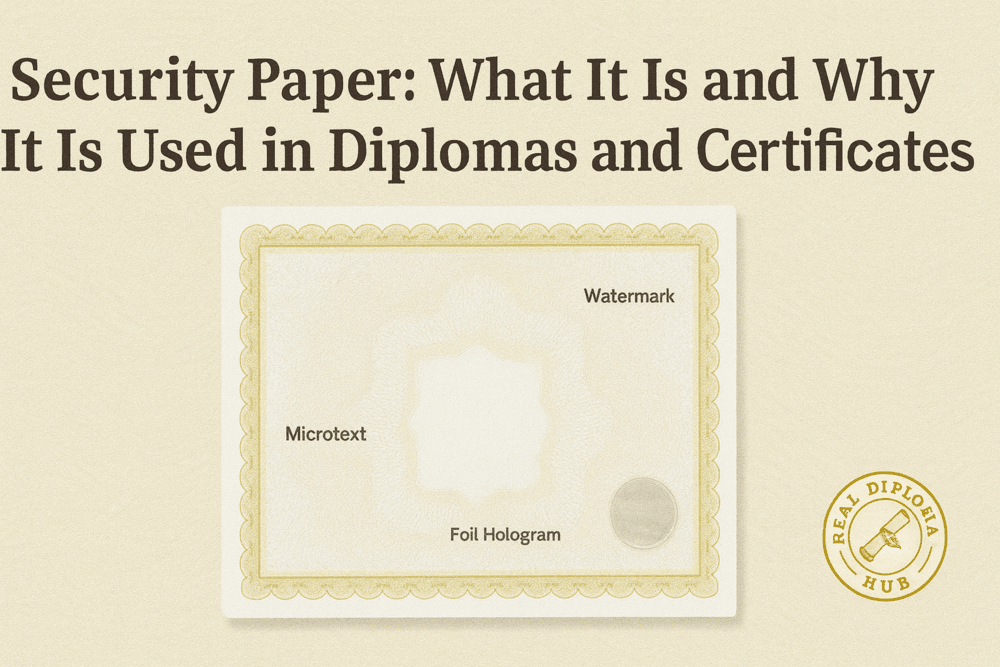
Security Paper: What It Is and Why It Is Used in Diplomas and Certificates
Why Security Paper Feels Well, Secure?
If you have ever held an official diploma, government-issued certificate, or bank cheque, you might have noticed it feels different from ordinary paper. There is often a watermark, a subtle pattern, or even a special texture. That is not just for looks this is security paper. It is designed to protect important documents from forgery or tampering.
I remember the first time I compared two certificates side by side. One printed on plain cardstock, the other on true security paper. The difference was not just visual. The security paper had this layered, can not just photocopy me vibe. It felt official in a way that made you think twice before even bending it.
The Good Stuff About Security Paper
Security paper is more than just fancy paper. It is engineered to protect authenticity, making it a must have for high value documents like diplomas, certificates, legal agreements, and even event tickets.
Here is why institutions love it:
- Anti Counterfeit Features - Built in security elements like watermarks, microtext, holograms, and colored fibers make duplication extremely difficult.
- Professional Appearance - Looks premium, with intricate patterns or hidden marks that instantly convey importance.
- Tamper Evidence - Some security papers show visible signs if altered, helping prevent fraud.
- Long-Lasting Quality - Many types are acid-free and designed to resist fading, yellowing, or damage over time.
When someone holds a certificate printed on security paper, they do not just see the achievement, they feel its authenticity.
The Not So Perfect Side
As great as it is, security paper does have a few drawbacks:
- Higher Cost - More expensive than regular paper or cardstock because of the advanced production process.
- Special Printing Needs - Certain security features require compatible printers or professional printing services.
- Handling Limitations - Over handling can dull some printed security features (like raised ink).
- Bulk Shipping Costs - Heavier and thicker options can increase postage expenses.
Still, for something meant to last and represent genuine accomplishment, the trade off is worth it.
My Tips for Using Security Paper in Diplomas & Certificates
- Match the Features to the Purpose - For academic diplomas, watermarks and microtext work well. For event tickets, holograms or color shifting inks may be better.
- Always Use High Resolution Printing - Security paper deserves crisp, clear printing to maintain professional quality.
- Store Properly - Keep unused sheets in a clean, dry, secure location to prevent damage or unauthorized access.
- Work with Trusted Suppliers - Ensure you are buying from legitimate sources to avoid counterfeit security paper.
Quick Comparison: Security Paper vs. Cardstock vs. Regular Paper
| Feature | Security Paper | Cardstock Paper | Regular Printer Paper |
|---|---|---|---|
| Security | High anti-counterfeit features | None | None |
| Durability | High | High | Low |
| Appearance | Professional & official | Premium & formal | Basic & casual |
| Cost | Higher | Medium | Low |
| Best For | Diplomas, certificates, legal docs | Certificates, awards, invitations | Everyday printing |
Final Thought
Security paper is the gold standard, if you want your diplomas, certificates or other official documents to be taken seriously and stay secure. It is not just about looking official, it is about protecting the integrity of what the paper represents. Once you see the difference in both appearance and function, you will wonder why you ever settled for plain paper.